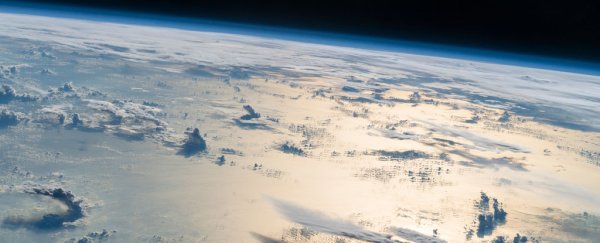Honouring the commitments made at last year's historic Paris climate deal will take a huge international effort to lower carbon emissions – but scientists say there's another way we can help reduce rising global temperatures at the same time.
In a process called solar geoengineering, light-reflecting particles could be introduced into Earth's stratosphere to bounce the Sun's rays back into space and keep the planet cooler. While this controversial concept has been discussed for decades, the risks of geoengineering have kept the research largely sidelined – but now researchers say they might have a way of making it safe.
Solar geoengineering usually refers to dispersing sulphate aerosols (sulphur-rich particles) into the stratosphere. This naturally occurs during volcanic explosions, where the particles reflect sunlight and have a cooling effect on the planet.
But the problem with sulphate aerosols, according to researchers at Harvard University, is that they produce sulphuric acid in the stratosphere, which damages the ozone layer.
But what if we used a different kind of aerosol, which could still reflected sunlight but didn't take a toll on ozone?
"Anytime you introduce even initially unreactive surfaces into the stratosphere, you get reactions that ultimately result in ozone destruction, as they are coated with sulphuric acid," says atmospheric scientist Frank Keutsch from the Harvard John A. Paulson School of Engineering and Applied Sciences.
"Instead of trying to minimise the reactivity of the aerosol, we wanted a material that is highly reactive but in a way that would avoid ozone destruction."
Looking for particles capable of neutralising sulphuric, nitric, and hydrochloric acid on their surface, the team ran through the periodic table.
Eventually, after extensive simulations, they discovered that calcite – a constituent of limestone – was what they needed, as it can convert the acids into stable salts.
"Essentially, we ended up with an antacid for the stratosphere," says Keutsch.
Mimicking stratospheric conditions in lab experiments, the team says that calcite can indeed reflect light while countering ozone loss – and its abundance on Earth would also make it a practical resource for geoengineering.
"Calcite is one of the most common compounds found in Earth's crust," says applied physicist David Keith. "The amounts that would be used in a solar geoengineering application are small compared to what's found in surface dust."
But despite the promising new lead, the team says a huge amount of additional research needs to be done before we start injecting this material into the sky.
"Stratospheric chemistry is complicated and we don't understand everything about it," says Keith.
For one thing, at the heart of the process would be a massive chemical reaction taking place in the atmosphere, due to the way the calcite neutralises acids.
"Calcites scatter sunlight more or less the say way that acid droplets do, and they don't heat the lower stratosphere as much," Keith told Eric Niiler at Seeker.
"The primary purpose is that they are a base and react with strong acids in the stratosphere – it makes salt, which would rain out. That would reverse the problem of the ozone hole."
While that might be good for the ozone in the atmosphere, we don't know what the environmental effect of salty rain would be on oceans and soil – nor how the reactions would ultimately play out in the polar regions.
"We can be certain there would be unintended consequences," says Keith. "What they would be nobody has looked at in a serious way because of this taboo against research."
The reasons for that taboo are varied. Some say solar geoengineering is an unproven distraction that takes attention and resources away from the established science of clean, renewable energy and other conventional efforts to lower carbon emissions.
And the potential dangers of a botched geoengineering endeavour aren't to be understated – it even ranked as a high-risk environmental threat on a list of global catastrophic risks published earlier this year.
Which is why the researchers say we need to keep researching the potential of geoengineering science. Reducing our carbon emissions is our best chance of mitigating the dangers of climate change this century – but if light-reflecting particles can safely help us out at the same time, there could be a big opportunity to embrace here.
"My view is that solar reengineering is a supplement, and in the end we still have to cut emissions," says Keith.
"But cutting emissions doesn't cut the risk. A combination might to a better job."
Find out more about the research in the video below:
The findings are reported in the Proceedings of the National Academy of Sciences.
